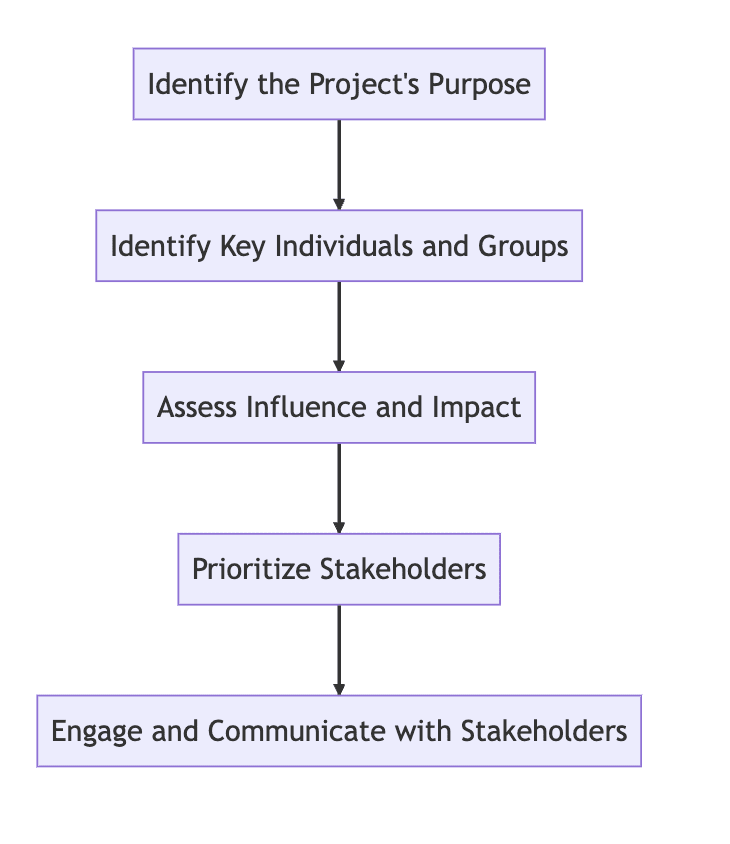
In any project or initiative, the process of identifying stakeholders is a crucial step toward achieving success. Stakeholders are individuals or groups who have a vested interest or influence in the outcome of a project. By involving stakeholders from the beginning and considering their perspectives, organizations can make informed decisions and gain their support. This article will delve into the process of identifying stakeholders, provide useful tools and techniques, discuss the challenges involved, and highlight the benefits of engaging stakeholders.
Understanding Stakeholders
Definition of Stakeholders
To embark on the process of stakeholder identification, it is crucial to possess a comprehensive comprehension of who exactly the stakeholders are. Stakeholders encompass a wide range of individuals, including employees, customers, suppliers, and investors, as well as various groups such as communities, regulatory bodies, and non-governmental organizations (NGOs). It is imperative to recognize that each stakeholder holds varying degrees of influence and interest, underscoring the importance of accurately identifying them in order to facilitate effective project management.
For example, imagine you’re managing the construction of a new office building. Your stakeholders might include the client, the architect, the construction team, local government authorities, and the future occupants of the building. Each stakeholder will have specific requirements and expectations. The client may prioritize cost-effectiveness, the architect may focus on design aesthetics, the construction team may emphasize safety and efficiency, and the future occupants may value functionality and comfort.
The Process of Identifying Stakeholders
To identify stakeholders effectively, a structured process should be followed. Here are the key steps involved:
Step 1: Identify the Project’s Purpose
The first step in the stakeholder identification process is to clearly define the purpose and objectives of the project. This clarity helps determine who might be affected by or have an interest in the project. It also assists in defining the scope and boundaries of stakeholder identification.
Step 2: Identify Key Individuals and Groups
Next, it is essential to compile a comprehensive list of potential stakeholders. This involves considering both internal and external stakeholders, ranging from team members and executives to customers and partners. Brainstorming, conducting research, and reviewing existing project documentation can aid in this identification process.
Step 3: Assess Influence and Impact
Once the list of stakeholders is established, it is important to assess the influence and impact of each stakeholder on the project. Factors to consider include their authority, expertise, resources, and level of interest in the project. Categorizing stakeholders based on their level of influence helps prioritize engagement efforts.
Step 4: Prioritize Stakeholders
Based on the assessment of influence and impact, stakeholders should be prioritized. This involves identifying key stakeholders who have significant influence or high interest in the project. By focusing on these stakeholders, organizations can allocate their resources and efforts effectively.
Step 5: Engage and Communicate with Stakeholders
Engaging stakeholders is crucial for effective project management. This step involves developing a communication plan and actively involving stakeholders in decision-making processes. Regular communication, such as meetings, updates, and feedback sessions, should be established to keep stakeholders informed and engaged throughout the project lifecycle.

Tools and Techniques for Identifying Stakeholders
There are several tools and techniques that can aid in the identification of stakeholders:
Stakeholder Mapping
Stakeholder mapping is a visual representation of stakeholders and their relationships to the project. It helps identify the level of influence, interest, and potential alliances among stakeholders. This technique assists in understanding the dynamics and power dynamics within the stakeholder network.
Stakeholder Interviews
Conducting interviews with key stakeholders can provide valuable insights into their expectations, concerns, and potential contributions to the project. These interviews allow for open and direct communication, building rapport and trust with stakeholders.
Surveys and Questionnaires
Surveys and questionnaires are effective tools for gathering information from a large number of stakeholders. They can be designed to gather specific data related to stakeholder interests, concerns, expectations, and suggestions. Surveys and questionnaires can be administered online or in person, allowing stakeholders to provide their input conveniently. The collected data can then be analyzed to gain insights and inform decision-making processes.
Social Media Monitoring
In today’s digital age, social media platforms play a significant role in stakeholder engagement. Monitoring social media channels allows organizations to identify and understand the sentiment, opinions, and discussions surrounding their projects. It provides an opportunity to respond to concerns, address misconceptions, and gather feedback from a wide range of stakeholders.
Challenges in Identifying Stakeholders
Identifying stakeholders can present various challenges that need to be addressed:
Identifying Hidden or Silent Stakeholders
Some stakeholders may not be immediately apparent or vocal about their interests or concerns. These hidden or silent stakeholders can still have a significant impact on the project. It is important to conduct thorough research and engage in dialogue to identify and involve these stakeholders in the decision-making process.
Dealing with Conflicting Stakeholder Interests
Different stakeholders often have diverse and sometimes conflicting interests. Balancing these interests can be a complex task. Effective communication, negotiation, and compromise are essential to address conflicting interests and ensure that decisions align with the overall project objectives.
Keeping the Stakeholder List Updated
Stakeholder identification is an ongoing process, as new stakeholders may emerge or existing stakeholders’ roles may change over time. It is crucial to regularly update and review the stakeholder list to ensure that all relevant parties are accounted for and engaged appropriately throughout the project.
Importance of Stakeholders
Stakeholders offer diverse perspectives, drawing upon their unique backgrounds and experiences. This diversity enriches the decision-making process and promotes innovative thinking, leading to more robust and well-rounded project outcomes. Other benefits include :
- Engaging stakeholders fosters collaboration and reduces resistance to change.
- Stakeholder involvement ensures alignment with the needs and expectations of those affected.
- Stakeholders provide valuable insights for risk management.
- They contribute recommendations and strategies to mitigate potential risks.
- Stakeholders help identify opportunities for improvement throughout the project.
- Their expertise and knowledge contribute to continuous innovation.
- Involving stakeholders enhances decision-making and project outcomes.
- Stakeholders act as a source of continuous improvement and adaptation.
- Their involvement increases the likelihood of project success and smooth implementation.
By proactively involving stakeholders from the initial stages of a project and giving careful consideration to their needs and expectations, project managers can effectively minimize resistance to change. This approach fosters a sense of ownership and buy-in among stakeholders, ultimately boosting the likelihood of project success and ensuring a seamless implementation process.
Conclusion
The process of identifying stakeholders is a crucial step in project management. By understanding and involving key individuals and groups, organizations can harness their perspectives, expertise, and resources. This article has outlined the process of identifying stakeholders, discussed useful tools and techniques, highlighted potential challenges, and emphasized the benefits of engaging stakeholders. By prioritizing stakeholder engagement and communication, organizations can improve project outcomes and foster positive relationships with stakeholders.
FAQs
- Why is stakeholder identification important in project management? Stakeholder identification is important in project management because it helps organizations understand who may be affected by or have an interest in the project. Engaging stakeholders from the beginning allows for informed decision-making and increased project success.
- How can stakeholder interviews benefit the identification process? Stakeholder interviews provide an opportunity to gather direct insights and feedback from key stakeholders. They help uncover stakeholders’ expectations, concerns, and potential contributions to the project.
- What is stakeholder mapping, and how does it assist in the identification process? Stakeholder mapping is a visual representation of stakeholders and their relationships to the project. It helps identify the level of influence, interest, and potential alliances among stakeholders, aiding in understanding the stakeholder network dynamics.
- **How can organizations address conflicting stake

